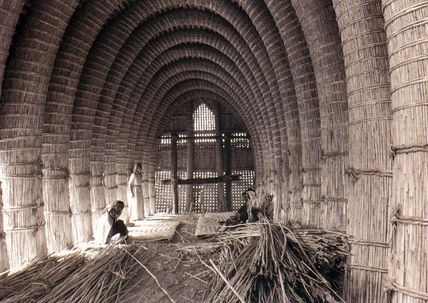
Southern Iraq Rush House
Wilfred Thesiger, Pitt-Rivers Museum, Oxford
Content created: 2005-07-21
File last modified:
Go to
Essay 1,
Essay 2,
Essay 3,
Metal Ages.
Mesopotamia is essentially a wide plain, roughly corresponding to modern Iraq, through which the Tigris and Euphrates rivers run from north to south, joining together at the south end of the plain and flowing together into the Persian Gulf. (The name Mesopotamia literally means “land between the rivers.”)
In a slightly more extended sense, Mesopotamia also refers to all the areas that eventually came to be part of the same broad cultural system, including the mountain areas that rim the valley and even distant colonies of Mesopotamian traders. The area of Mesopotamia roughly corresponding with the portion of Iraq south of Baghdad is known as Sumer, and as far as we know, Sumer was the earliest “civilization” in the technical sense of having a domesticated food (and beer) supply and writing. Mesopotamia will provide us with an example of the processes involved in the development of “civilization.”
The term “civilization” is of little practical use in the study of any particular society, but comes into its own in the broad analysis of the whole sweep of human tradition, when certain societies emerge that seem to function on a scale qualitatively greater than that of many others. The term “civilization” is difficult to define exactly and yet still in a useful way. If we wish to characterize civilization broadly rather than strictly define it, most often it is linked to (1) urbanization, (2) a state (or city-state) type of political organization, (3) division of labor into specialized professions, often divorced from food production, (4) elaboration of artistic, religious, and/or ceremonial life, and usually (5) the development of literacy. The idea of scale is critical to the general concept, and in archaic civilizations the social integration necessary to organize large groups of people always entailed considerable social inequality. This inequality, troubling as it is to our modern sensibilities, has been so inevitable in earlier societies that some theorists even build it into the definition of civilization itself:
… it is generally agreed that the idea [of civilization] implies a degree of human control over environmental forces as well as a developed system of social control and adequate leisure to permit an advanced level of esthetic appreciation. Most civilizations are characterized by a fairly advanced division of labor, a rather stable system of social stratification and the delegation of social power to a leisured class of aristocrats who play a dominant role in determining the direction of social and economic effort, favoring esthetic activities and interests over the more gross satisfactions [!] of the primitive tribesman. (Pearson 1985: 51) [Source]

Wilfred Thesiger, Pitt-Rivers Museum, Oxford
As we have seen, the earliest evidence for agriculture in Mesopotamia is from village sites like Jarmo that were occupied after about 8000 BC. From about 8000 BC to 5000 BC people in Mesopotamia lived in villages each housing between 100 and 300 people. By 5000 BC these villages had become fairly close to one another, with many in sight of each other and very few more than a day’s walk from their nearest neighbors. By 4000 BC the population of the villages and the area covered by each had increased a great deal, largely as a result of improved agriculture and animal husbandry sustaining higher population densities. The first domesticated plants, low-yielding emmer wheat and two-row barley, gave way to higher-yielding strains, and sheep, goats, and cattle became common instead of rare. Hill country villages like Jericho and Jarmo were where the action was.
But it was not to last. For reasons that have inspired many hypotheses, the hill-dwellers began to lag behind the people of the river basin in the exploitation of the social possibilities that agriculture created.
The prime example (“type site”) for the Mesopotamian agricultural villages of the more developed sort at around 4000 BC is Al Ubaid, located in southern Iraq, that is, in Sumer. Indeed, many villages of the so-called Ubaidian phase seem already to have enjoyed a stable and even comparatively wealthy agricultural economy at about the same time. The remains of these villages included stone hoes, adzes, querns, pounders, and knives as well as clay sickles, loom weights, spindle whorls, and figurines, and a distinctive variety of painted pottery (Kramer 1963: 39) [Source].

The wide distribution of Ubaidian pottery shows that they engaged in some trade with surrounding peoples. They lived in houses made by covering a reed framework with mud (a technique called “wattle-and-daub”) and topping it with a thatched roof. All that seems very Neolithic. But they also built large buildings of adobe brick that seem to have been temples.
According to later, literate Sumerian tradition, the development of Ubaidian civilization was abruptly interrupted by a great flood, which some modern scholars believe is also reflected in the tale of the flood of Noah in the Bible (Genesis 6-9). Archaeological evidence at Al Ubaid confirms such a flood covering Ubaidian sites. Shortly after this time, new peoples arrived, probably nomads from Syria and Arabia (Kramer 1963: 40), who lived with those who had survived the flood. The newcomers brought copper working techniques and introduced the potter's wheel, and their pottery began to replace the Ubaidian painted ware in the archaeological record. It may be that these newcomers also developed writing, for the first written language, “Sumerian,” may reflect their speech. A third migration came from the east about 3000 BC, and it appears that late, “classic” Sumerian civilization arose as a result of the interaction, and eventually merging, of these three groups.
Writing first appeared some time before that third migration, but it was mostly devoted to bookkeeping and provides us little that is revealing about many aspects of the Sumerian cultural system. But by 2500 BC the earliest texts appear that allow some fairly well-based inferences about Sumerian society and culture. Some time during this period, perhaps at roughly 3000 BC or just before, the people of Sumer began using occasional copper and possibly bronze sickles. They wore clothes made from sheepskin and worked imported gold, silver, and copper. The ox-drawn plow is also known from about the same time, although the major transport animal was (and is) the ass. (Horses, when they were introduced a thousand years later, were principally used to pull war chariots.) By 1600 BC the art of glassmaking had developed to the point where glass bottles could be produced.
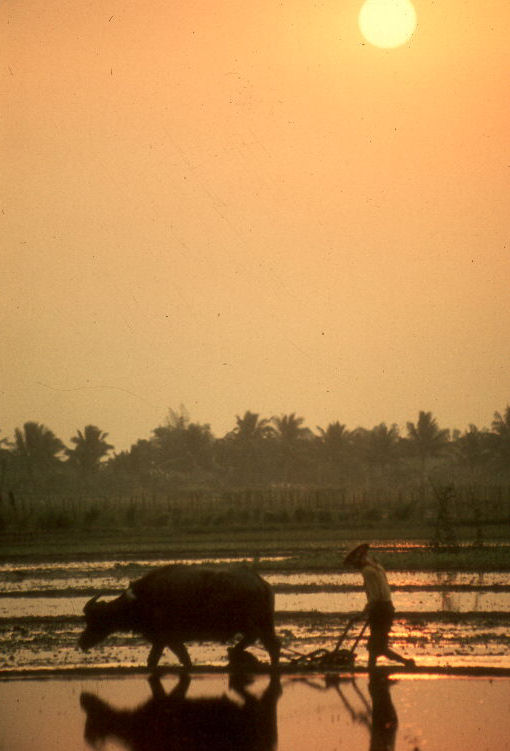
photo by DKJ
The Sumer of 3000 BC was divided into a number of independent city-states and lacked an over-arching political administration. A prime factor in promoting cooperation and restricting conflict between the city-states was water control. The Tigris and Euphrates rivers were subject to occasional, unpredictable, and often disastrous flooding, sometimes just before harvest, when floods threatened to ruin crops. Mutual aid was essential at such times. At other, more usual, times, natural water was inadequate, and the Sumerians developed an intricate system of canals crisscrossing the entire area to provide irrigation for crops. Each city-state was an administrative center for the agricultural land and had a canal system immediately servicing it, but the canals of different cities crossed and linked, and the administration of this system of canals (and the mediation of associated disputes) provided a link binding the city-states.
In addition to lacking regular supplies of agricultural water, which made the canal system necessary, the Sumerian towns lacked many other natural resources, such as stone, timber, limestone, lead, copper, gold, silver, and even bitumen (a kind of natural asphalt used to stick things to each other). This is not surprising, since the valley of two rivers had for millennia been the depository of soils washed down from the mountains.
They had to engage in far-flung trade to acquire these raw materials, and thus each city was not only the social center for an agricultural population, but, at least as importantly, a manufacturing and trading center. (The outgoing trade items, so far as we can tell, must have been largely perishable agricultural products: grain, fish, dates, cloth, leather, and the like. Some intangible trade items, as postulated for Çatal Hüyük, cannot be excluded.)
One of the most important and earliest of these Sumerian city-states was Uruk, a site that also gives its name to a period of vigorous expansion beginning about 3600 BC. Like other Sumerian city-states, Uruk was an economic (and probably political) center for farming hamlets all around it.
Research conducted by Guillermo Algaze of UCSD centers on the curious fact that many of the items traded (such as silver, gold, and lapis lazuli, a semi-precious stone) were being imported at the pleasure of Sumerian elites. (Everybody likes gold, but it is hard to argue that it was “needed” except to show off.) As the elites became more important about 3400 BC in towns like Uruk, they encouraged ever more trading relationships northward, until people of Sumer’s Uruk period cities maintained a system of satellite communities or outposts spread over modern Iraq, Iran, Syria, and even Turkey to assure a steady flow of elite goods.
Since what are found archaeologically are only the traces of exchange goods, it is of course hard to tell who actually lived in these “colonies,” Sumerians or their local agents. Even Sumerian refugees are a remote possibility! (Algaze notes [1993] [Source] that the site of Habuba Kabira on the banks of the northern Euphrates in Syria, for example, is laid out exactly like southern Mesopotamian cities.) Algaze argues that this long-distance trade was an important, even critical, factor in the expansion and development of the Sumerian cities as they competed with each other for size and glory.
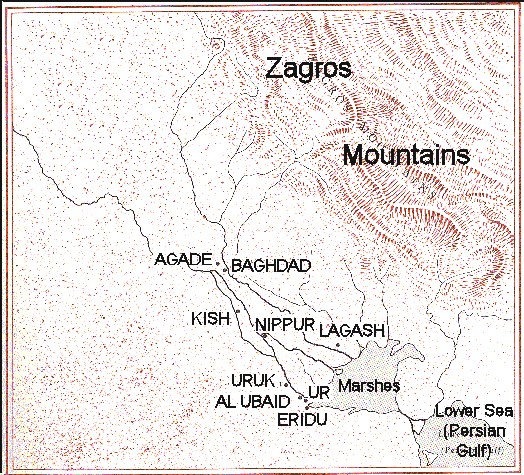
One reason why elite goods were so important in early trade, whether in Mesopotamia or in China, as mentioned earlier, is that such goods provided the wherewithal for people in power to demonstrate that they were different from other people, with the implication that it was appropriate for them to be in power. This process is sometimes referred to as the “mystification” of political authority. Although the full process is difficult to reconstruct from archaeological materials alone, the ability to monopolize rare commodities (like gold) or highly valued ones (including human labor or even human life) seems to be a cornerstone of the political division of labor that underlies the success of archaic states in creating large-scale social systems. (Click here for More About symbols, sumptuation, and mystification.)
In the similar case of very early Egypt, one source (Adams & Ciałowicz 1997: 52 [Source]) summarizes the role of elites as follows:
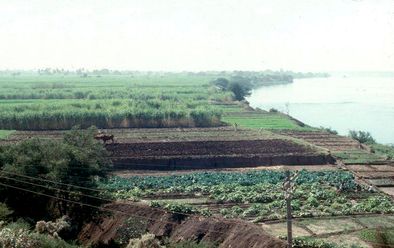
photo by DKJ
The colonization of the Delta and the rise of the aristocracy were connected in a continuous loop: [1] the conquest of new territories brought about the enrichment of families and individuals as well as the accumulation of property in the hands of the few; [2] bigger élite graves, into which greater quantities of goods were put, stimulated demand for the production of more; [3] and this in turn necessitated the colonisation of further territories and seizure of commercial routes. Egypt moved inexorably towards a national court culture under one king, who strengthened bureaucratic control over Egypt by monopolising the supply of luxury items through trade, controlling their production in royal workshops and dispensing patronage to the nobility.
Naturally, being able to engage in trade requires that one have access to resources that can be traded. In a article provocatively subtitled “The Mesopotamian Advantage,” Algaze argues that between 5000-3000 BC, the combination of good agricultural resources and good water transportation resources —the Tigris and Euphrates rivers— provided the emerging Mesopotamian elites the means to bolster their social position through trade, and may have been the reason why Sumer was the earliest archaic state to emerge (Algaze 2001) [Source].
The central role of Sumerian elites in this trade is most likely not merely because luxury goods were included. It appears that the trade was not privately conducted, but was rather the business of the state itself, probably in the form of a temple system with important economic and political functions. Sumerian cities shared a common religious system based on a pantheon of the patron gods of the various towns. An interesting myth has survived in a later written text and appears to have been important to the Sumerians. In the myth a council of gods divides the lands of Mesopotamia into different territories with one god in charge of each city. Such a myth could provide a rationale for the systems of cooperation required by irrigation works, as well as the “friendly” competition in trade.
There is some controversy about how important religious sentiment may have been in the day-to-day politics of the Sumerian cities of 2500 BC, but they all had impressive temples, and among the temple staffs are listed attendants, craftsmen, laborers, and food producers, suggesting that the temples were intimately involved with the economic system.
Political control in each city-state was in the hands of the en (“lord”), lugal (“king), or ensi (“governor-priest”), depending on the period being considered, and it seems clear that religious belief and civic responsibility were intimately associated with each other. Indeed, it is in the cities of Sumer with their domination by “temples” that we find the earliest political states with a hierarchy of social classes and a system of governmental bureaus centered on kings.
Most Sumerian families were not elite, of course. They worked as farmers, merchants, and artisans. Indeed, Uruk society seemed to support a surprising number of artisans, producing pottery and other goods at several levels of quality. The farmers did not own their land in early Sumerian days, but rented portions of it from the temple and paid a tax to the temple each year. The tax was usually 10 percent of the crop, a modest enough amount by most later standards, including our own. The land could not be sold or mortgaged by its workers because it belonged to the god. By 2000 BC, however, private ownership of land had become more prevalent, and it is inviting to speculate on the evolutionary forces that led to this change. A smaller amount of land was also worked under the direct management of priests, the labor being provided by serfs and slaves.
Guilds for the various crafts were very important in a city’s organization, and there were stringent laws governing the guilds and apprenticeship to them. There was also a class of slaves, typically prisoners of war or bankrupts who had sold themselves to pay off their debts. It appears that a household functioned as an economic unit under the name of a senior man. Texts suggest than a man facing household bankruptcy could sell his wife, sons, and daughters to redeem himself. Disobedient sons could also be sold into slavery. The king could call on both slaves and freemen to work on the canals, build roads, repair temples, and so on.
But it was clearly the “priests” who were the elite group in Sumerian society. The temples were apparently used as warehouses, which may indicate the sort of religious involvement in commerce hinted at by the lists of temple staffs mentioned earlier. [Note 1] In the earliest days the medium of exchange was grain. Later copper and eventually silver and gold were used as media of exchange, although loans were still sometimes paid in grain.
All commercial transactions were recorded, using a system of writing that seems to have been developed specifically for that purpose. Probably it was also as a consequence of their extensive trading relations that the Sumerians devised a system of arithmetic, including both whole numbers and fractions. They invented also a lunar calendar to keep track both of the various days on which rents were due and the days of temple ritual. Literacy was initially a skill of the priests, despite its being used almost exclusively for commercial purposes and not in ways we would think of as religious. (In later times a class of professional scribes arose, who were available, for a fee, to aid the lay citizenry in their business transactions.)
Learning in general, not literacy in particular, was the domain of the priesthood. Priests were, for example, the population from which judges and lawyers of the typical city were recruited, and it was priests who practiced medicine, using a wide variety of vegetable (and occasionally animal or mineral) products, oil enemas, dietary regulations, and other methods.
The vast majority of Sumerian documents that have come down to us have to do with trade and accounting, contracts, treaties with other city-states governing trade, laws governing commerce, and so on. It is through our ability to read these records that we have as good an understanding of Sumerian life as we have. It is also due to the peculiarly commercial focus of these texts that our knowledge of Sumerian economic life is much greater than our knowledge of some other areas of Sumerian culture.
Our example has been the site of Uruk, but Uruk was not alone. Many Sumerian cities are archaeologically known from the period after 3000 BC, even though Uruk remained a dominant center: Eridu, Ur, Erech, Lagash, Nippur, and Kish are the most famous. A brief description of the famous city of Ur, excavated early in the XXth century, will serve to represent them all here, as seen through their archaeological remains.
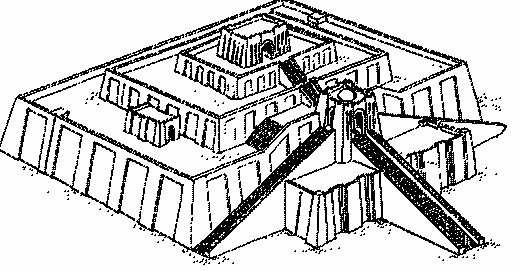
The Site of Ur. Ur was divided into three parts: a temple area, a royal palace, and a residential district. The temple area in the northwest corner dominated the walled city. Here a large, stepped pyramid (or ziggurat) of mud bricks rose twenty meters high and was topped by a shrine to the city’s patron, the moon god. This temple to the moon god dominated the city. Around it were the god’s storehouses and offices where the farmers’ rent produce was stored. The rest of the “sacred” area was filled with other “temple” structures. The common citizens never approached their city god directly, but had their own temples to lesser gods (and to the gods of other cities) by the hundreds throughout the city.
The king’s palace and lesser houses occupied a second area of the city. The third, residential area of Ur was made up of dozens of small, winding, unpaved, and apparently rather unplanned streets with houses of all sizes crowded together. Some of the larger houses were two or three stories high, but regardless of height all were built on the same basic plan, with the rooms grouped around a central courtyard. Some parts of the residential quarter appear to have been craft areas, and others look as though they were slums, where the poorest people probably lived. The population of Ur was estimated by its excavators to have been about 360,000 (Hawkes & Woolley 1963: 428) [Source].
Canals or no canals, common language and religion or not, the various cities fought each other quite often over water and land rights and other causes (possibly linked to foreign trade competition). Most of the population of any city was liable to the draft to fight in its wars. The common cultural tradition of greater Sumer is reflected in such warfare, however, which seems to have involved reasonably clear rules. For example, if captured in war, Sumerians could be ransomed by sale of their private property. If they could not raise the ransom, then their local temple or the state itself had to pay the ransom. (Or they served as slaves in the town that had captured them.)
In most respects such limited warfare had little effect on the general form of Sumerian society. Occasional conquest of one city-state by another would not change the basic rules by which society operated. Indeed it did not even change the god who owned the city. The new rulers would simply take over the care of the city god from the old ones and continue very much as before.
This was also true to a very large extent even when the entire region was occasionally conquered by a single ruler. That happened briefly about 2600 BC, when a strong king of the city of Ur managed to unite Sumer under the so-called First Dynasty of Ur. It happened more importantly with the rise to prominence of the northern cities of the Tigris-Euphrates region, the area north of modern Baghdad, in the area known anciently as Akkad (after the city of Agade). In about 2400 BC, King Sargon of Akkad conquered Sumer and unified Sumer and Akkad under a single royal house. This new entity was politically dominated by the Akkadians, but was Sumerian in general cultural style. [Note 2]
Far more important than the internal wars were the international relations that the Mesopotamians had to develop in order to protect their trade. Something akin to international law had to be developed (and enforced!) to protect the trading system in elite goods that was critical to the happiness of the elite families and hence to the maintenance of the system they dominated. So successful was this network that in later times the Akkadian language was used as a diplomatic tongue even in Egypt.
The most important considerations in the dawn of agriculture and the subsequent emergence of the archaic Bronze Age empires have now been laid out, with Mesopotamia the “classic case” that has dominated Euro-American archaeological attention and imagination for decades. Of course “pristine” civilizations —those arising without complex local antecedents or substantial admixtures from outside— arose in many other parts of the globe as well, usually within a couple of thousand years of the Mesopotamian developments. Eastern, Southern, and Western Eurasia all had such developments, as did Africa and the Americas.
We noted at the beginning of the Neolithic discussion that some specialists seek to explain this timing by reference to the end of the ice age, which led both to changes in human adaptations around the globe, and to increasing populations that almost required the development of agriculture, with its more predictable, if less varied and nutritious, food supply. Subsequent developments are then seen to cascade from there, with similar problems finding similar solutions over and over around the globe.
Others argue that there almost certainly has to have been a good deal of interaction between great centers, even though we can no longer trace it, so that innovations in one area gradually became known elsewhere and imitated where feasible, a process that is obvious enough within smaller regions like the Tigris-Euphrates basin or the Yellow River basin.
For purposes of these essays, our goal has been to identify and exemplify the processes —from climate change and genetic selection to value systems and elite trade— involved in the making of the modern world, and to understand the intellectual approaches by which we know about them. It has not been to discuss all the known cases. This chapter has provided an overview and a famous example. Accordingly our discussion ends here.
Return to top.
Go to
Essay 1,
Essay 2,
Essay 3,
Metal Ages.